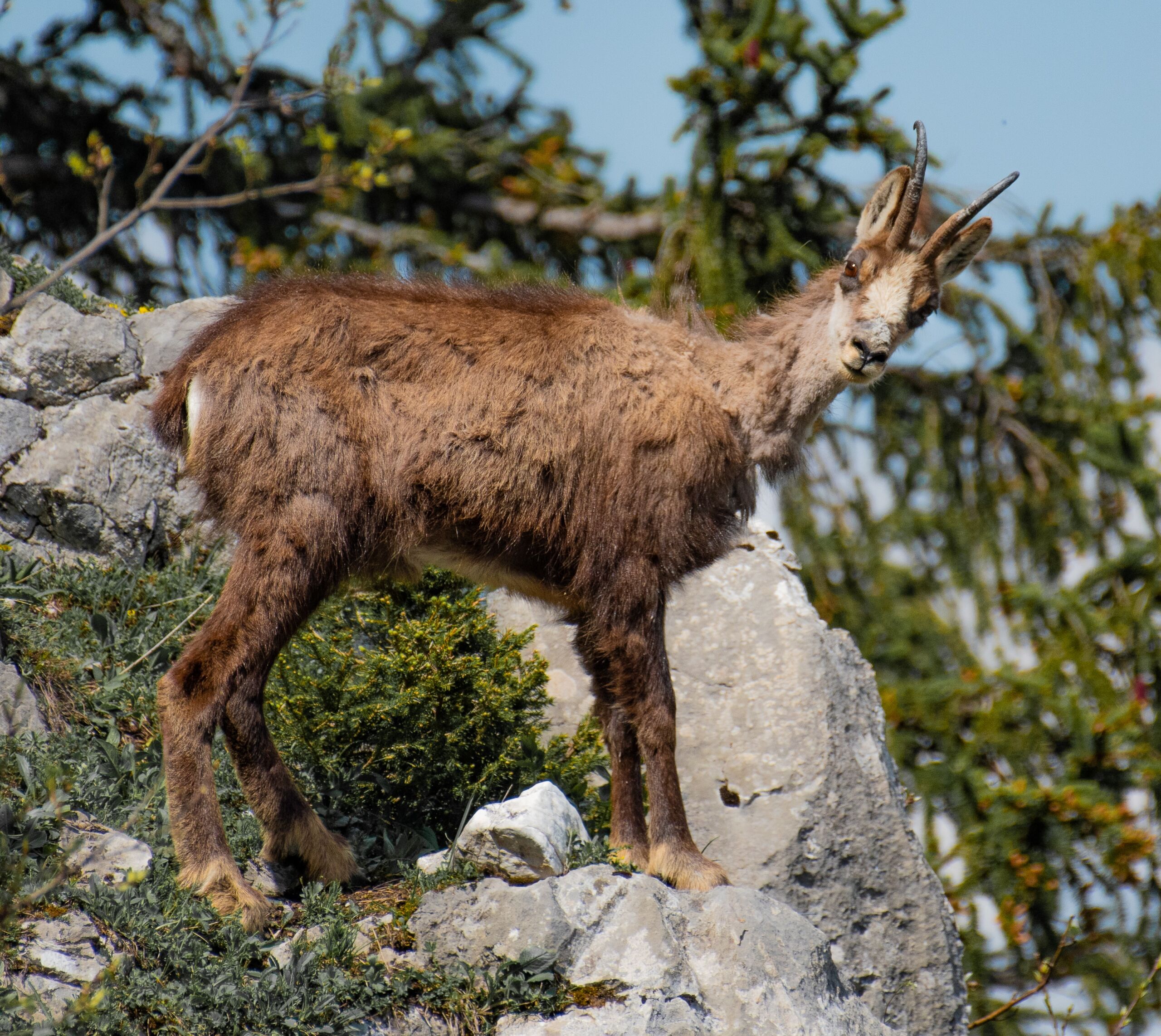
Alpine animals to observe while hiking
The best memories in the mountains are made of unexpected and rare moments. Having the chance to observe an animal in its natural habitat, up close or from afar, reminds us how fragile and beautiful nature is at the same time.
Might as well give ourselves every chance to observe chamois, bearded vultures, or even ptarmigans. I’m not saying it’s easy, but with plenty of observation, a bit of experience and time, one can spot and watch beautiful moments of wildlife life in the mountains.
The mountain animals you can observe while hiking include chamois, ibex, marmots, bearded vultures, golden eagles, black grouse, ptarmigans, snowshoe hares, bears, wolves, lynx and many insects, amphibians, and other creatures. It’s easier to observe mountain wildlife in spring and summer at dawn (5 am to 8 am) and at sunset (6 pm – 8:30 pm) because these are quieter times with fewer human activities.
Iconic mountain wildlife to observe
Not all mountain animals, whether from the Alps or the Pyrenees, are equally easy to observe. The ibex, which isn’t skittish and is large, is easy to identify even from a distance, unlike the ptarmigan whose camouflage renders it invisible even a few meters away.
Here is a non-exhaustive list of « mountain » species you can observe on a hike in the Alps and Pyrenees:
Chamois
The chamois is like the wild antelope of the mountains! Its agility and ease in navigating very steep terrain make it a fascinating and fearless mammal for us humans, who sometimes struggle just to stand upright!
They generally live between 1,500 and 3,000 meters in areas with an abundance of hiding spots and escape routes. This protects them from humans (and hunters) as well as some of their predators.
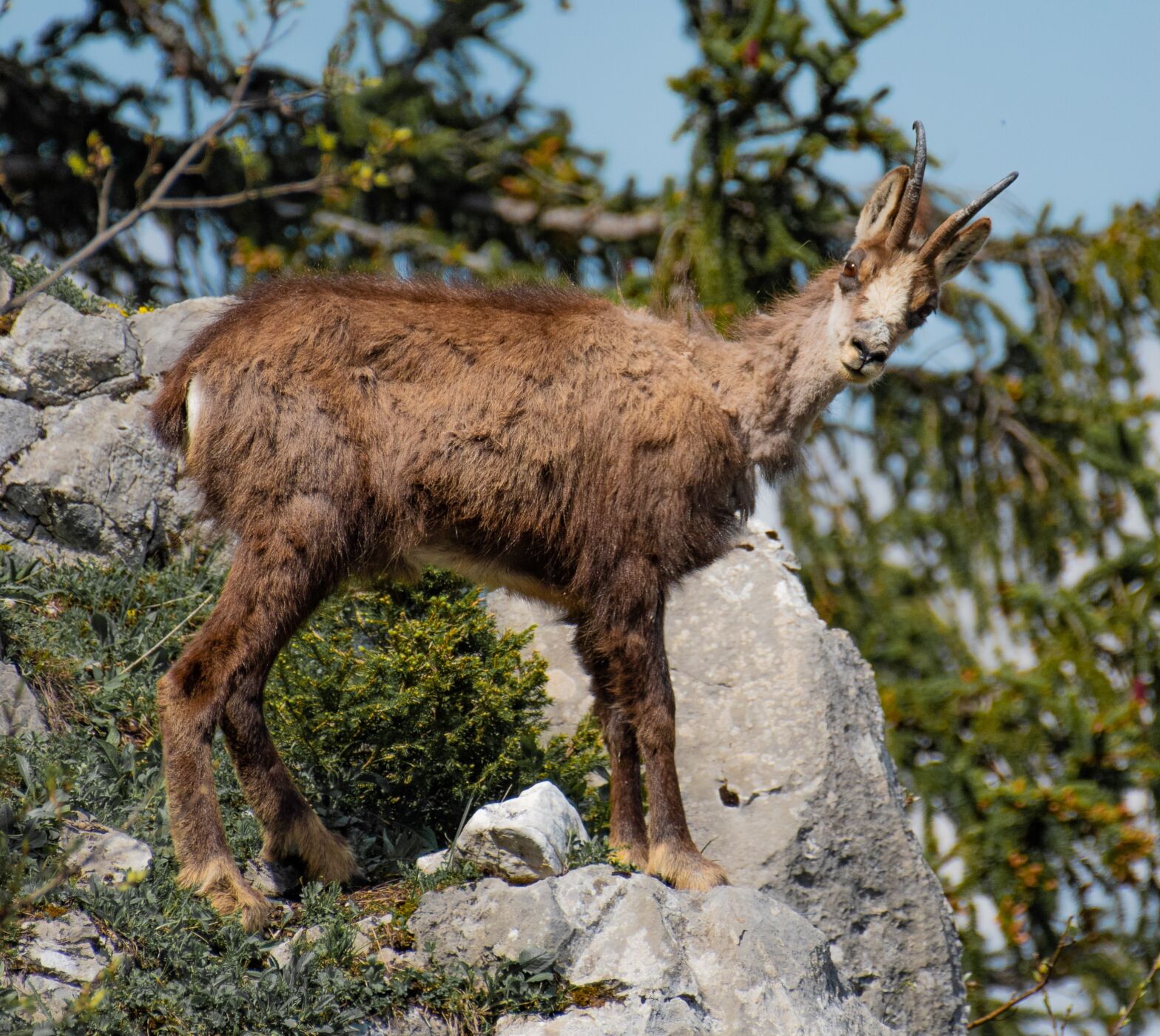
They favor rugged, rocky zones and inaccessible alpine pastures, but the « woodland » chamois also dwell in large coniferous forests.
The chamois is particularly recognizable by its small dark horns and white face marked by two black bands running from the muzzle to the eyes.
Its coat varies from light brown to dark black depending on the season and light. It is generally slightly larger than a goat, but smaller than an ibex.
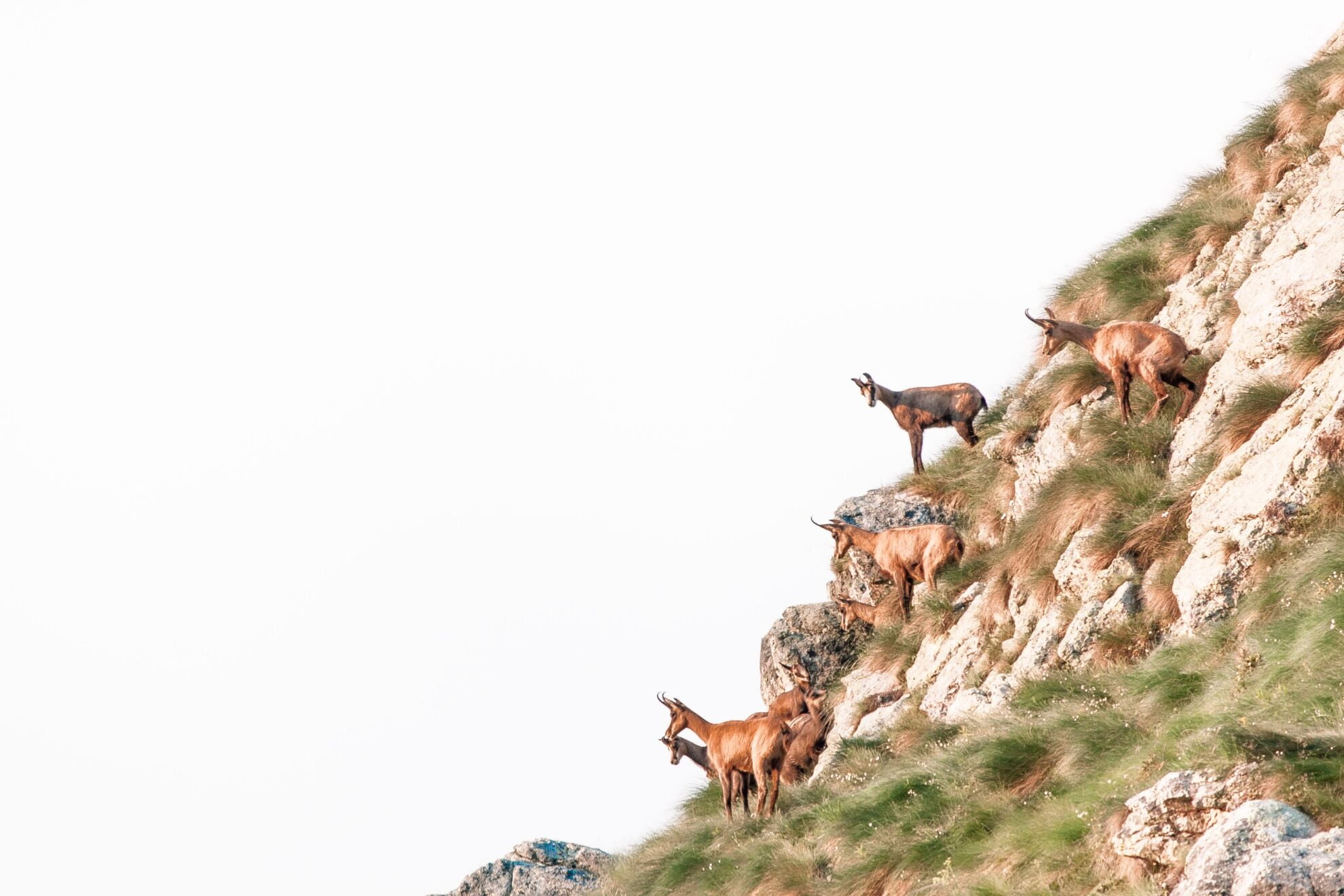
Ibex
The ibex, with its long curved horns, is recognizable from hundreds of meters away. It is not particularly skittish, and it’s not uncommon to approach within a few meters without disturbing it.
It nearly vanished during the 19th century due to intense hunting and poaching. Their recolonization of much of the Alps is thanks to the last protected ibex population in the Aosta Valley.
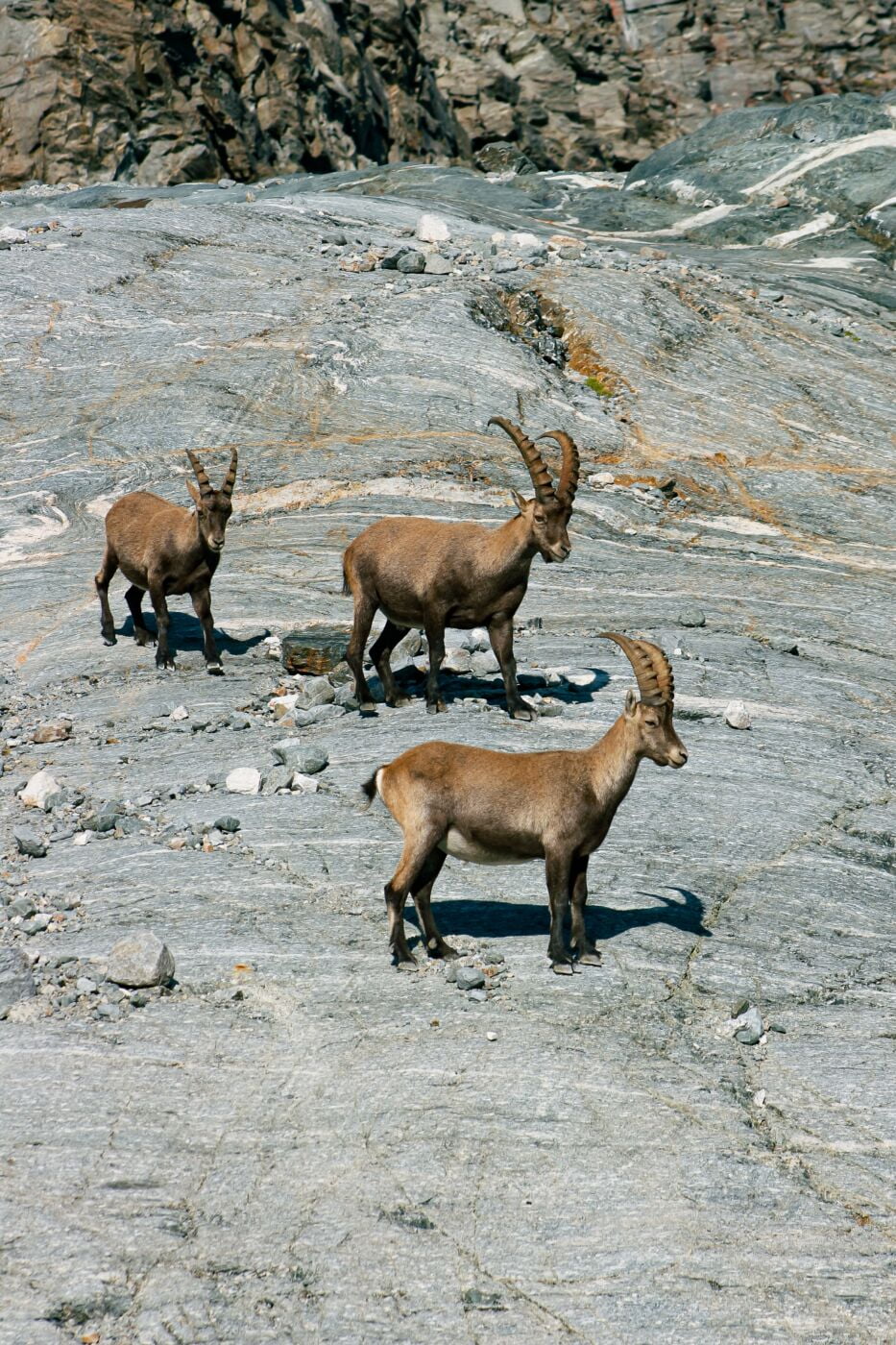
You can find them between 2,000 and 3,300 meters, at the edge of the highest pastures. Despite weighing around a hundred kilos, they navigate vertical terrain effortlessly.
Their very long horns, slightly knobbly at regular intervals—called age rings—actually help determine their age. Fifteen rings mean at least fifteen years old, possibly more.
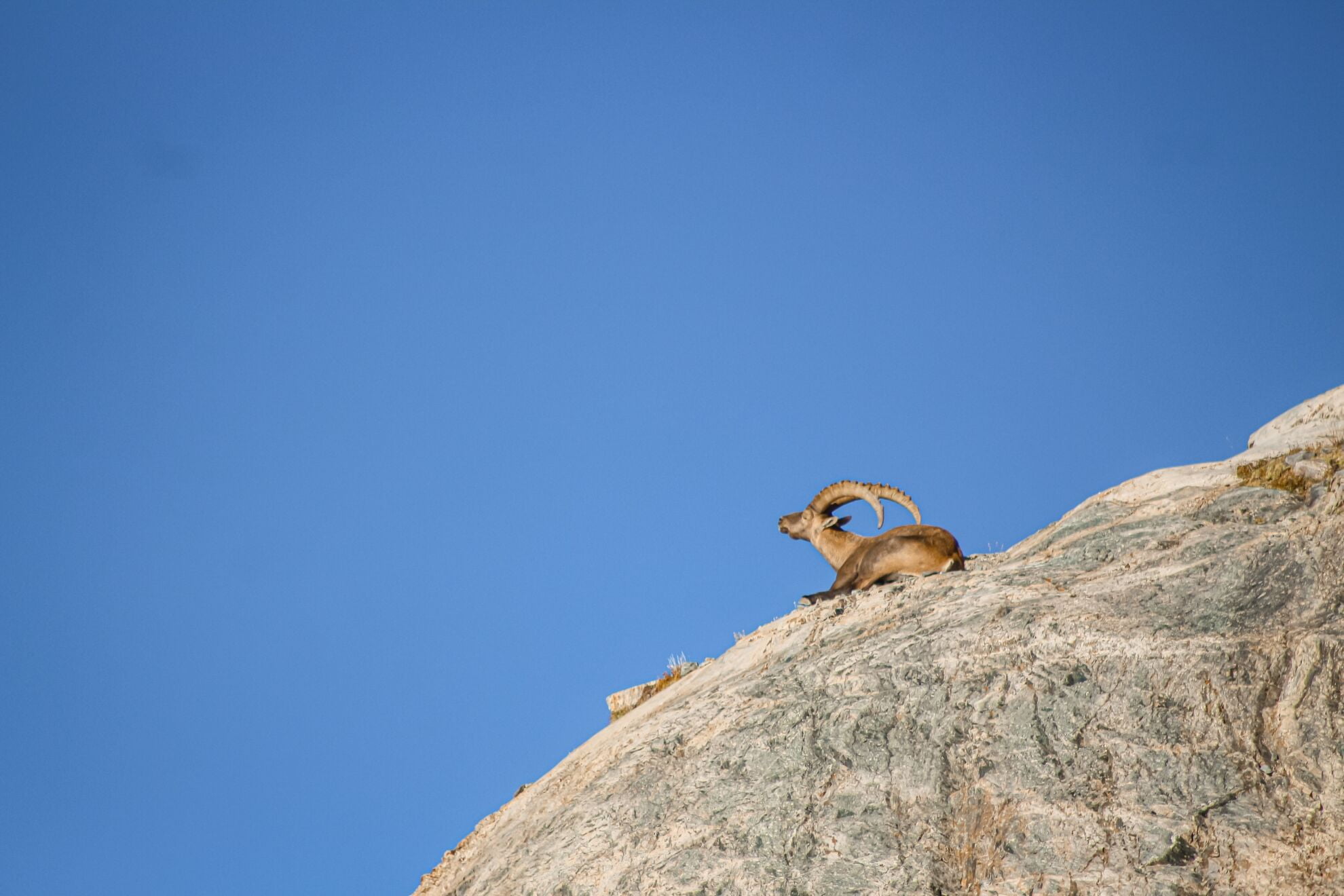
Marmot
The marmot is a small burrowing mammal, easy to observe and abundant in alpine pastures. They often live in colonies, typically family groups. They measure 30 to 70 cm depending on age and have attractive fur, once highly prized but thankfully no longer.
They inhabit various altitudes but prefer large grassy areas. They don’t need streams nearby; moisture from plants and dew suffices. You can find them up to 3,000 m. They favor open spaces to watch for danger. Their main predators are eagles and foxes.
Originally found in valleys and plains, marmots eventually took refuge in the mountains, away from humans and hunting.
The marmot is recognizable by its shrill cry echoing through the mountain. It stands on its hind legs as a sentinel, sounding an alarm that can be heard over a kilometer away.
You often hear the marmot before you see it!
Marmots are also known for hibernating. During snowy months, roughly late November to early April, they seal their burrow and slow their metabolism for months.
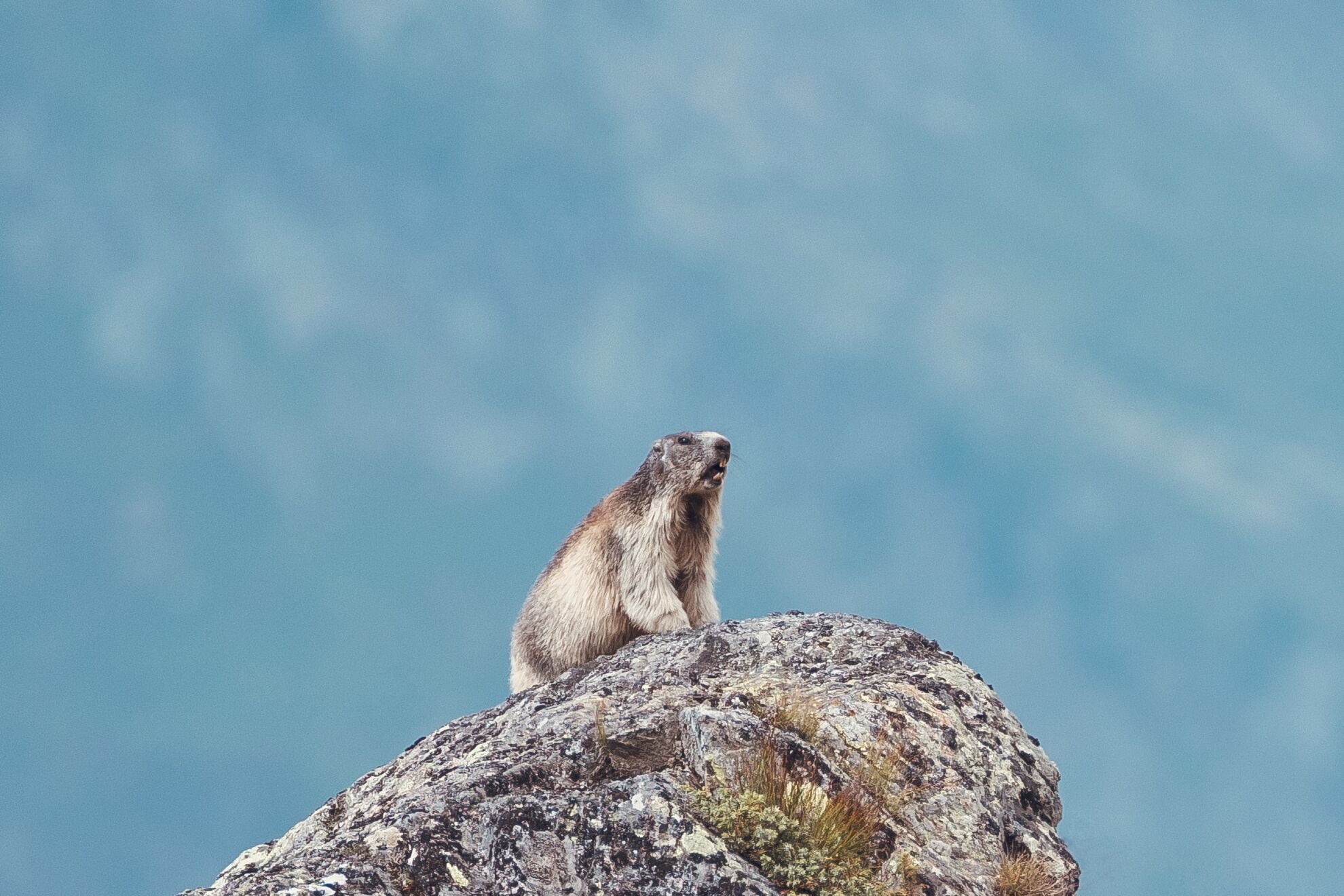
Bearded Vulture
This giant of the skies has an almost 3 m wingspan. The bearded vulture is a master glider, riding warm updrafts without flapping its wings. It spends its time scanning mountains and valleys for food. Despite its imposing silhouette, it’s harmless—it’s a scavenger that feeds only on carcasses.
Its pale body and dark wings are easy to spot even from afar. Unlike other large raptors, it flaps seldom and effortlessly soars from ridge to ridge.
Young bearded vultures have darker plumage until maturity, sometimes mistaken for eagles or buzzards.
Once extinct in the Alps for decades, successful reintroduction programs now let you see them across many French and Swiss Alpine ranges.
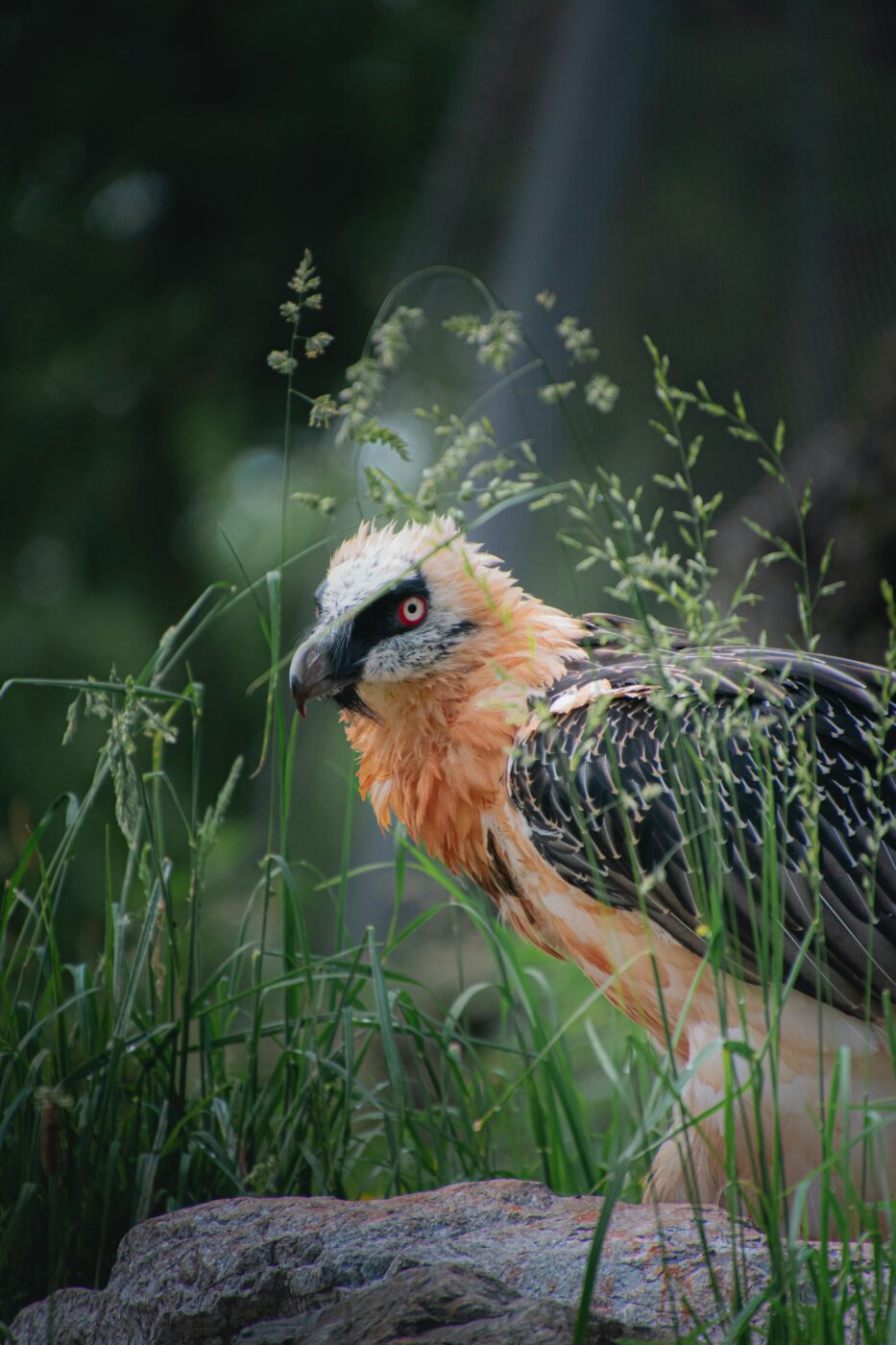
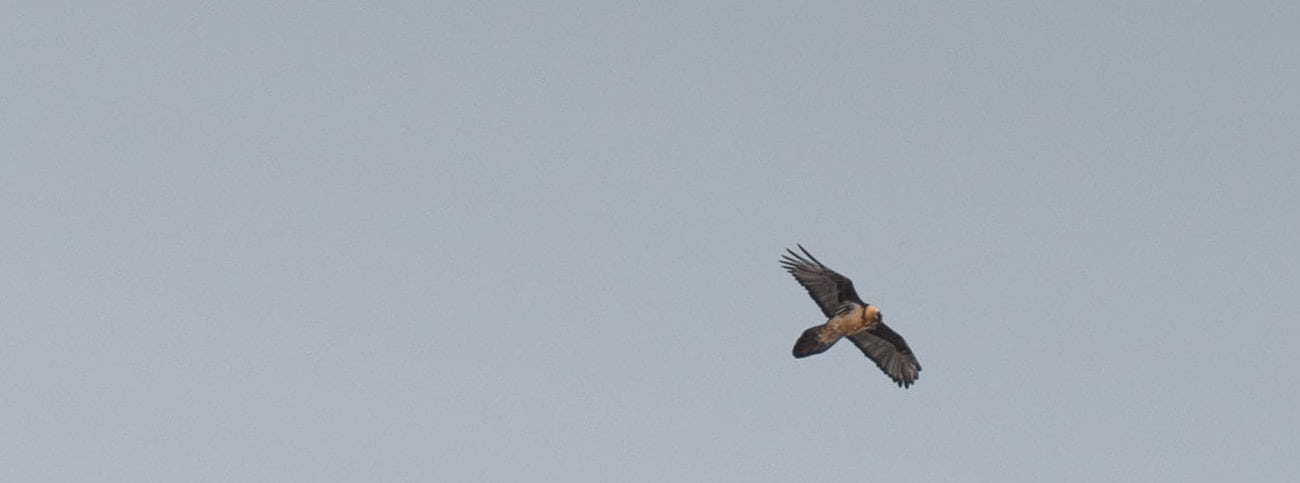
Golden Eagle
With a wingspan of 2.10 m to 2.50 m, the golden eagle patrols the skies like a guardian of the mountains.
Like the bearded vulture, it conserves energy by drifting on thermal currents. It traces methodical ellipses before gliding to the next warm column of air. Golden eagles require vast hunting territories, so it’s rare to see more than one soaring together.
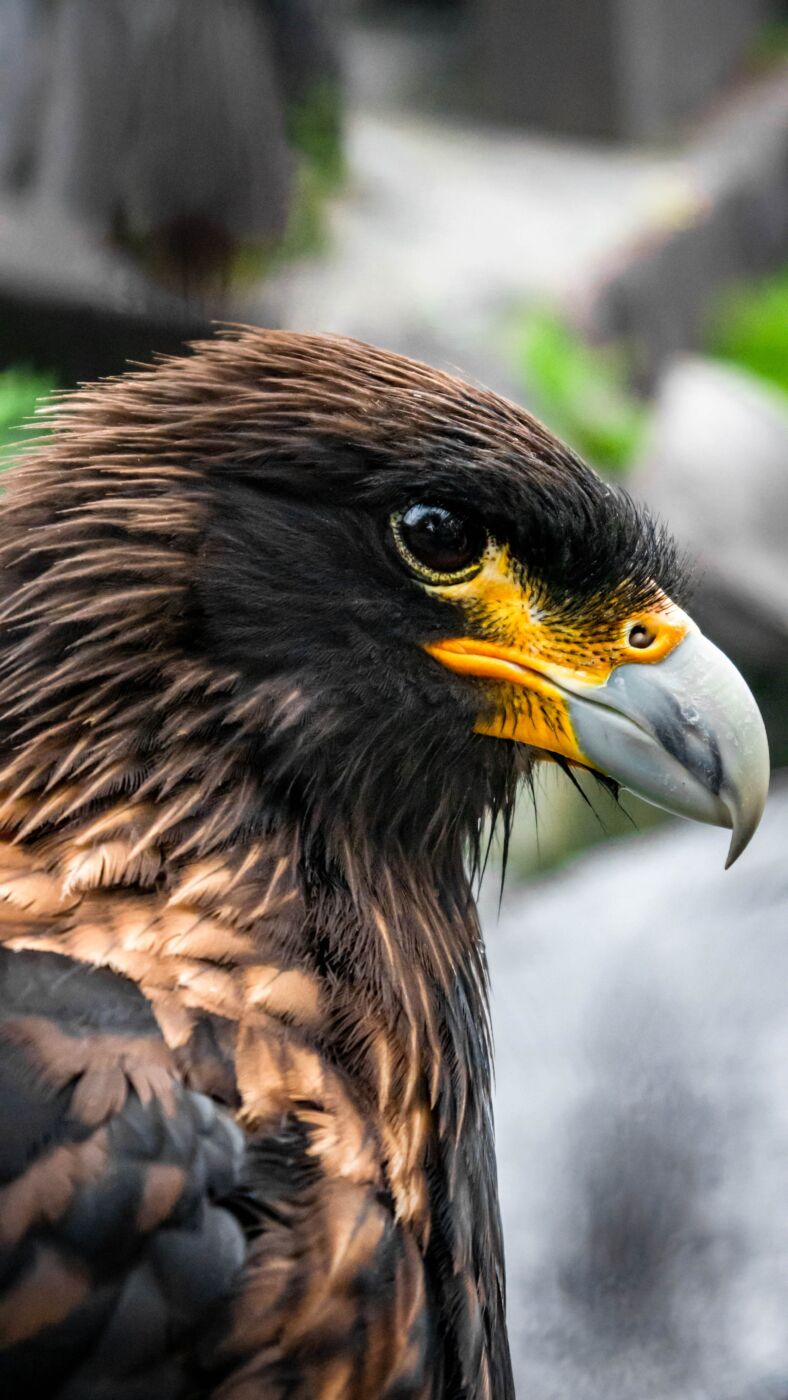
Golden eagle pairs often hunt together, typically half an hour after sunrise, following daily routes in search of prey.
Contrary to legend, they seldom attack large animals—rarely over 7–8 kg—and need only about 250 g of food per day.
They’re identifiable by dark plumage and a slightly lighter head. Juveniles display scattered white patches under their wings.
They nest in inaccessible spots—under overhanging rocks or on vertical cliffs—safe from rain and disturbance.
With piercing eyesight, they detect movement over a kilometer away and can dive at speeds up to 200 km/h! Marmots beware!
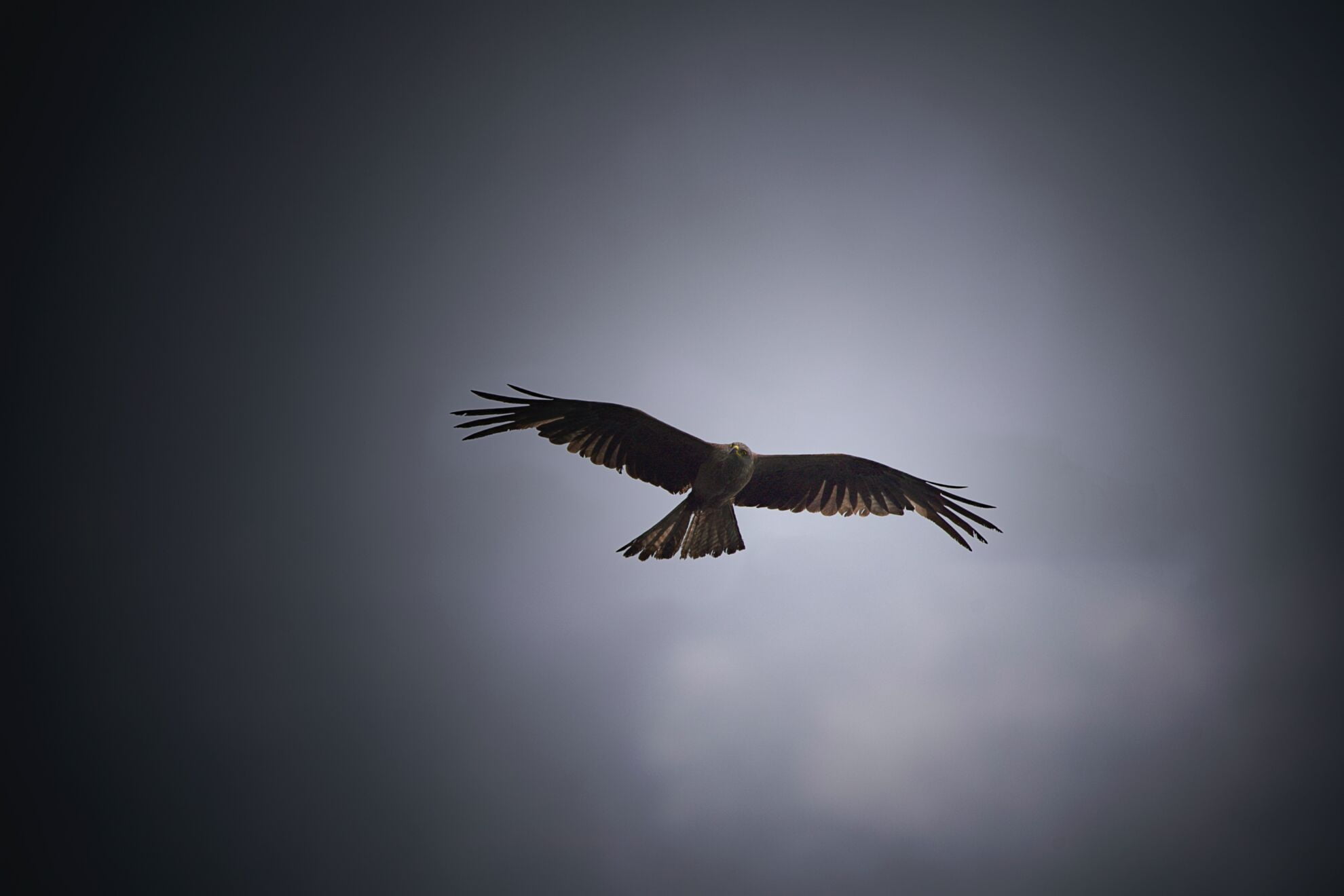
Black Grouse
The black grouse, or capercaillie, inhabits mountain forests where it finds ample cover and food year-round. This ancient bird struggles to adapt to changing environments. With ski resorts and increased human activities like hiking and ski touring, it faces serious extinction risks.
The black grouse is recognizable by its metallic-black plumage, lyre-shaped tail feathers, and red eyebrow wattles.
It’s famous for its unique mating display, where males parade and perform dances, calls, and songs to attract females.
Females are more discreet, with brown plumage that camouflages them while they nest in dense forest undergrowth.
Two close relatives, the capercaillie and hazel grouse, can also be seen in the mountains.
In winter, care is taken not to disturb them, and many ski areas now reserve quiet zones for grouse protection. Scarce winter food makes every bit of energy crucial, and disturbance can be fatal.
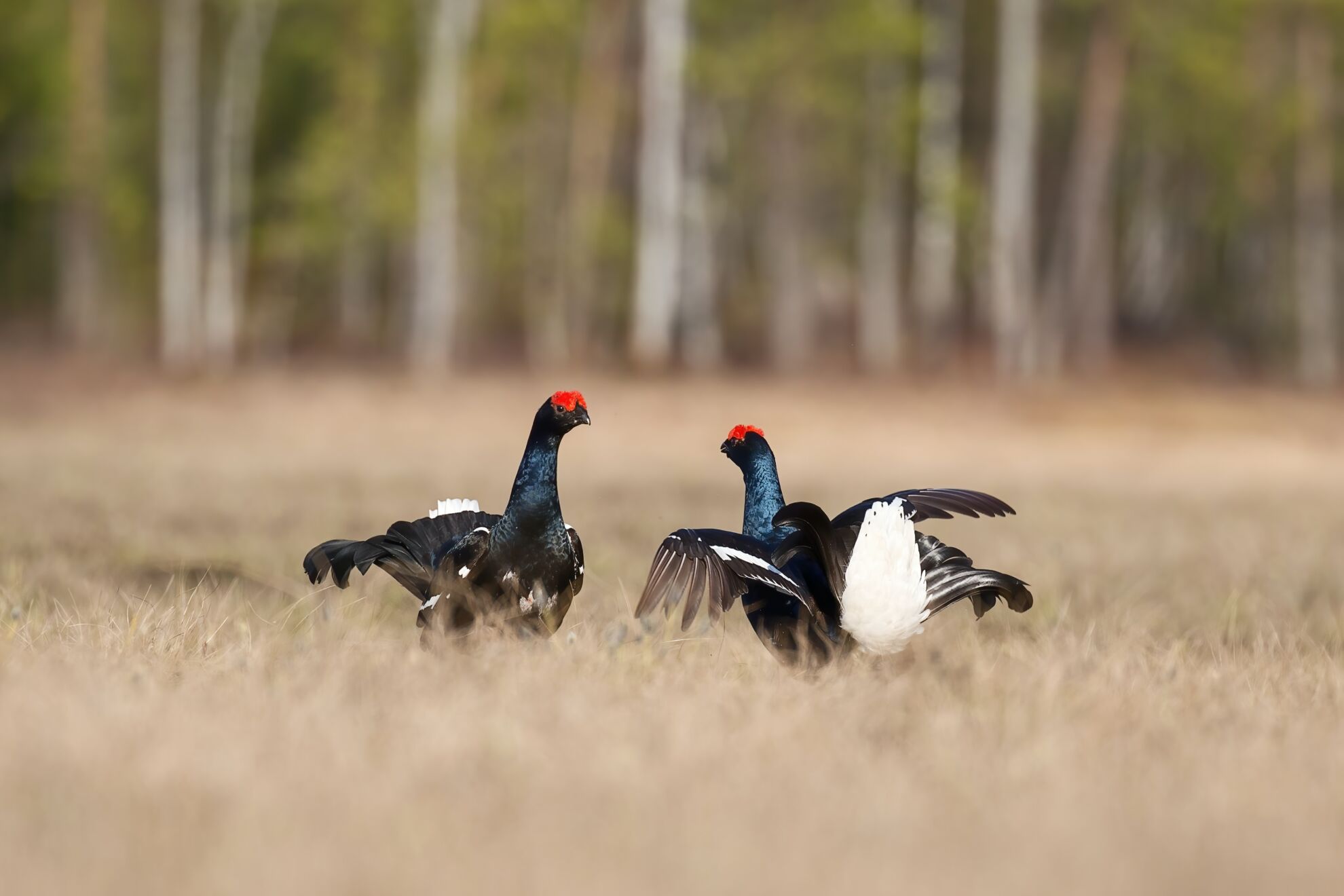
Ptarmigan
The ptarmigan is the camouflage champion. This elegant but elusive bird lives in open mountain areas and molts to blend with the seasons.
Its plumage shifts from brown/gray in summer to blend with rocks and roots, then to white and brown in autumn, transitioning to an all-white winter coat.
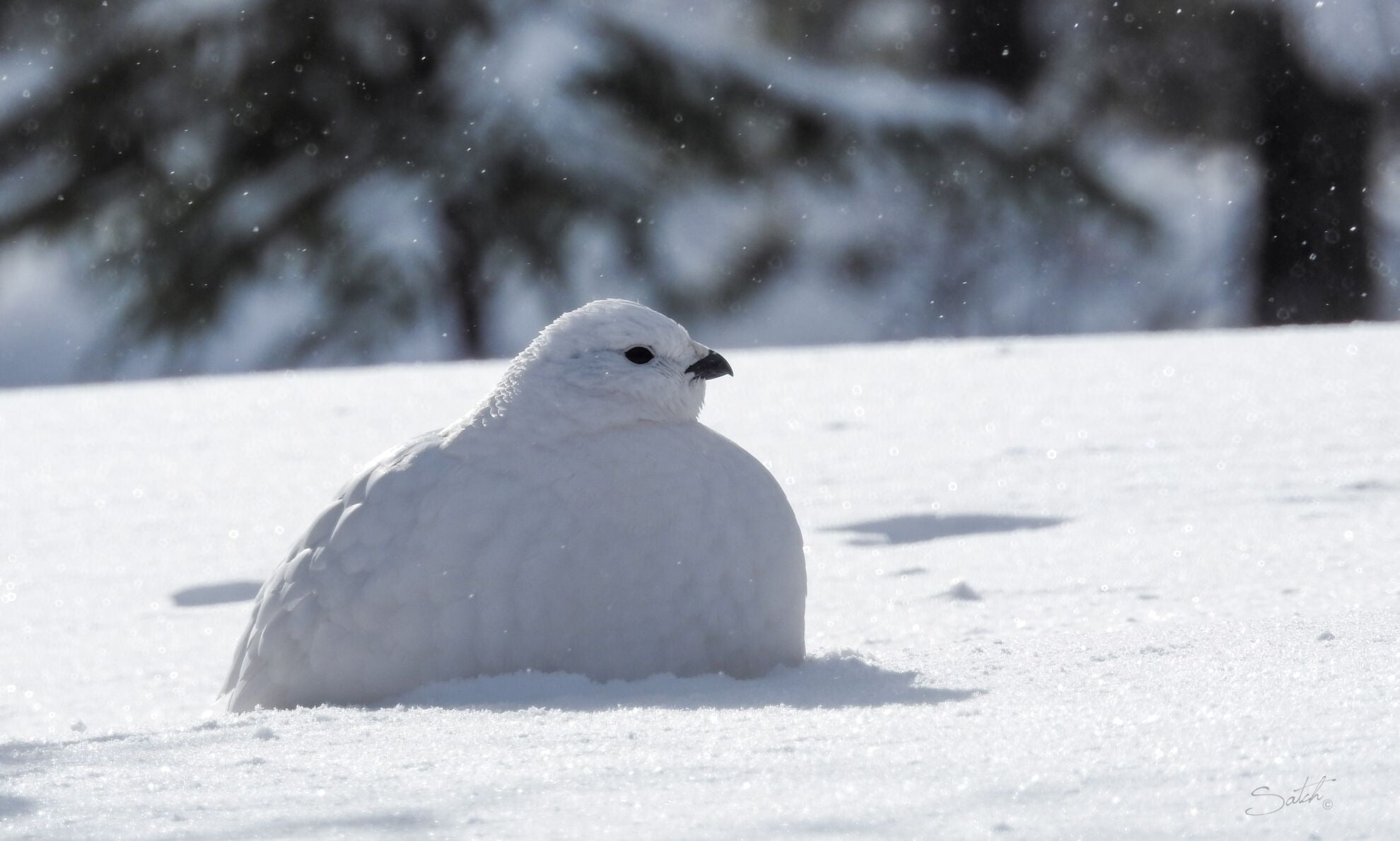
In winter, it’s pure white and nearly impossible to spot even meters away. I once mistook a fluffed-up patch of snow for a rock until it suddenly flew away! It was a ptarmigan avoiding me—truly unbelievable!
The ptarmigan is thus very hard to observe, yet endlessly fascinating. Like a mountain ghost, it’s everywhere and nowhere at once due to its invisibility!
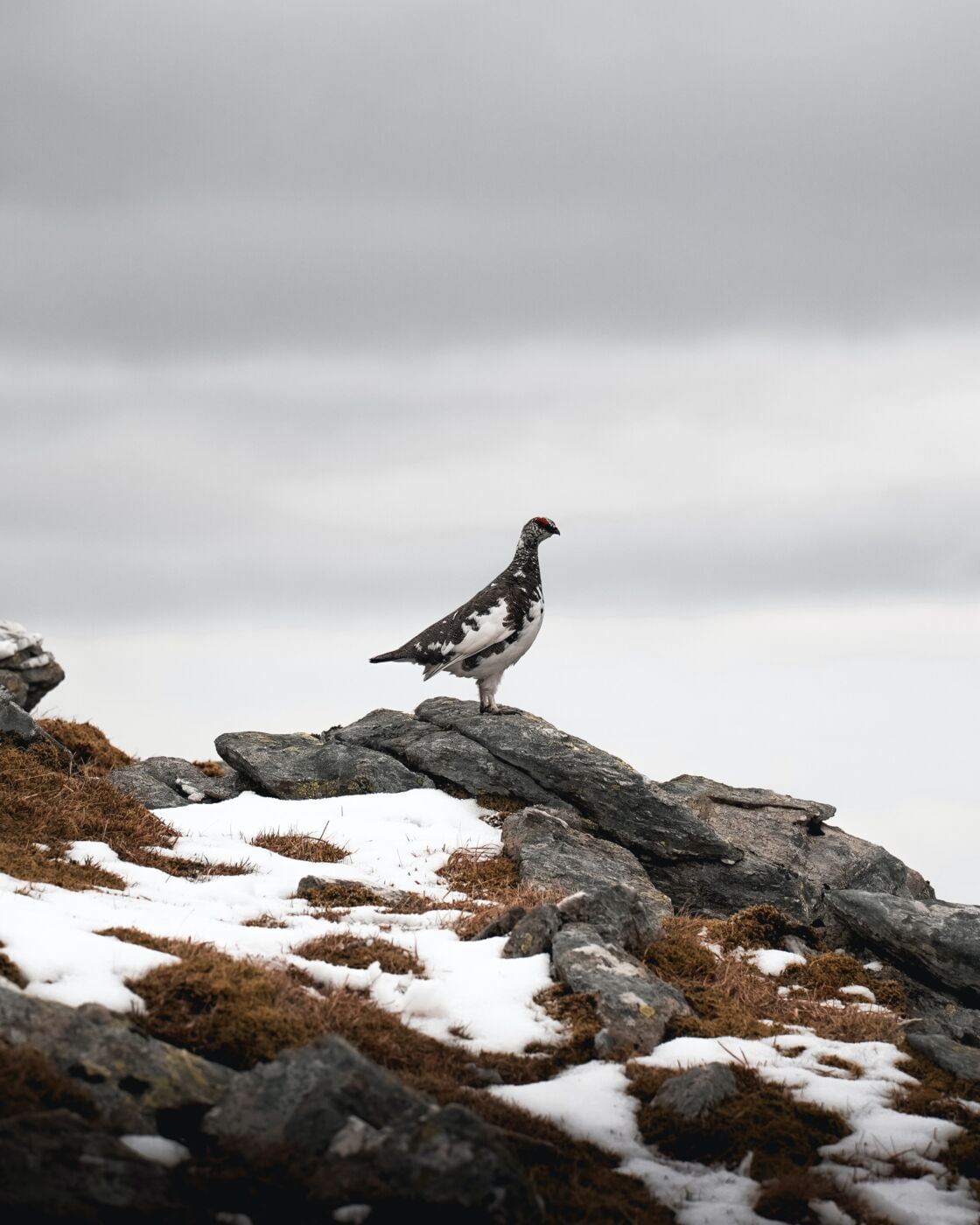
Wolf
The wolf is an iconic creature of our legends, and it’s been making a comeback in our mountains over the past twenty years.
Slowly returning from Italy in the Alps and from Spain in the Pyrenees, they live in family packs and continuously expand their territories.
Wolf sightings are increasing in plains, lower and mid elevations alike.
This unique predator plays a crucial role in controlling deer populations. In winter, you can spot their large paw prints and regular strides off trails, suggesting a wolf’s path.
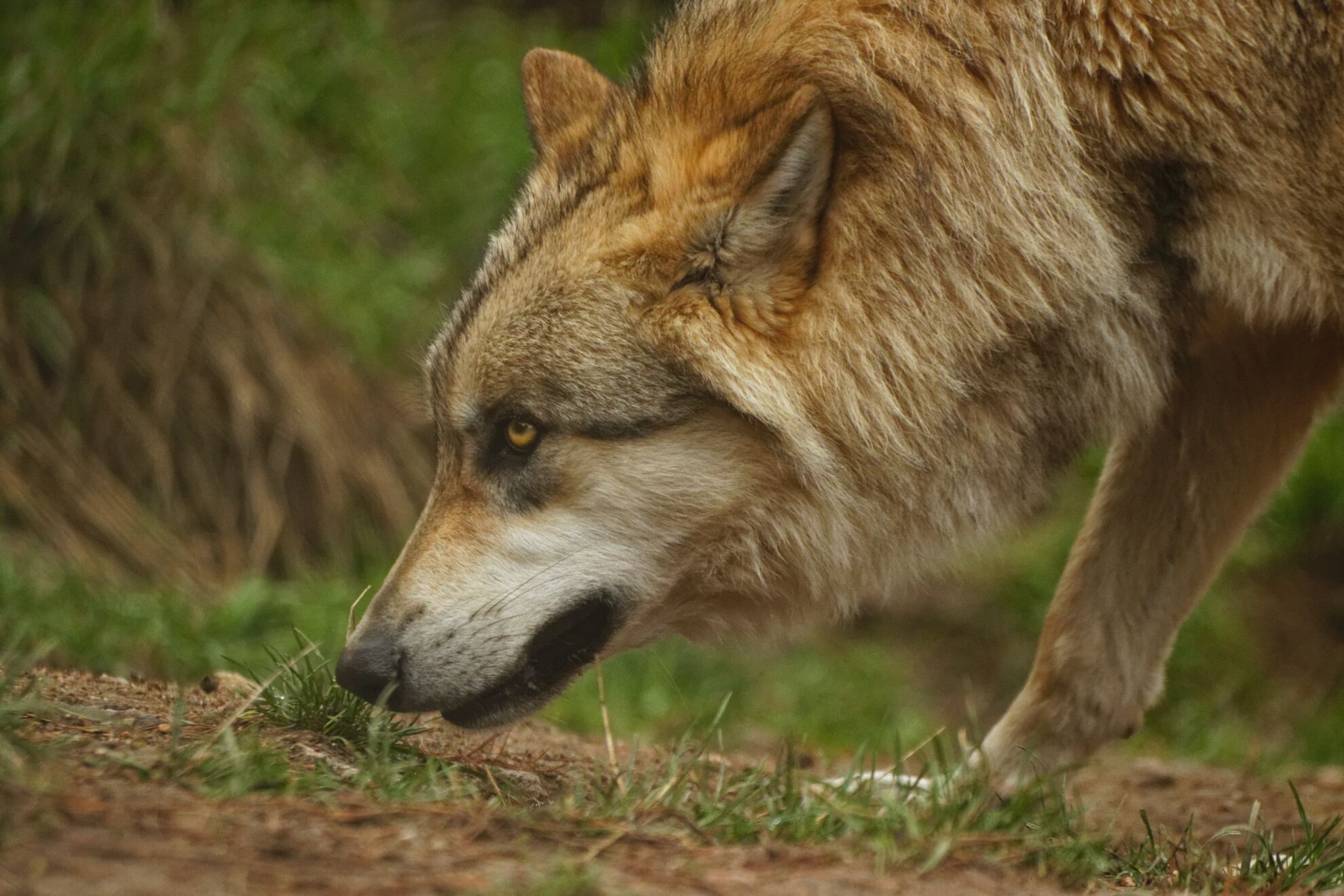
Lynx
The lynx is extremely discreet. Like a large cat, it moves silently. Solitary, unlike wolves, it needs a hunting territory of 50 to 300 km².
It favors forest environments and is easier to find in the Jura, though it’s been reintroduced in the Northern Alps. Its elusive nature makes it hard to assess the success of these efforts.
Its thick coat ranges from gray to brown or even golden-red with dark spots. This elegant feline is an extraordinary hunter.
It preys mostly on small mammals but can take down larger game like roe deer.

Bear
The bear needs no introduction. Alongside the wolf, it’s a legendary figure known by every child.
Absent from the French Alps for over a century, its return sparks heated debates!
However, it’s well established in the Pyrenees, where around 40 brown bears now roam following decades of reintroduction.
This impressive animal is cautious and observant despite its size. It savors wild berries and has acute hearing and smell, sensing food kilometers away!
Beware if you encounter a mother with cubs—she’s fiercely protective and may attack if she feels her young are threatened.
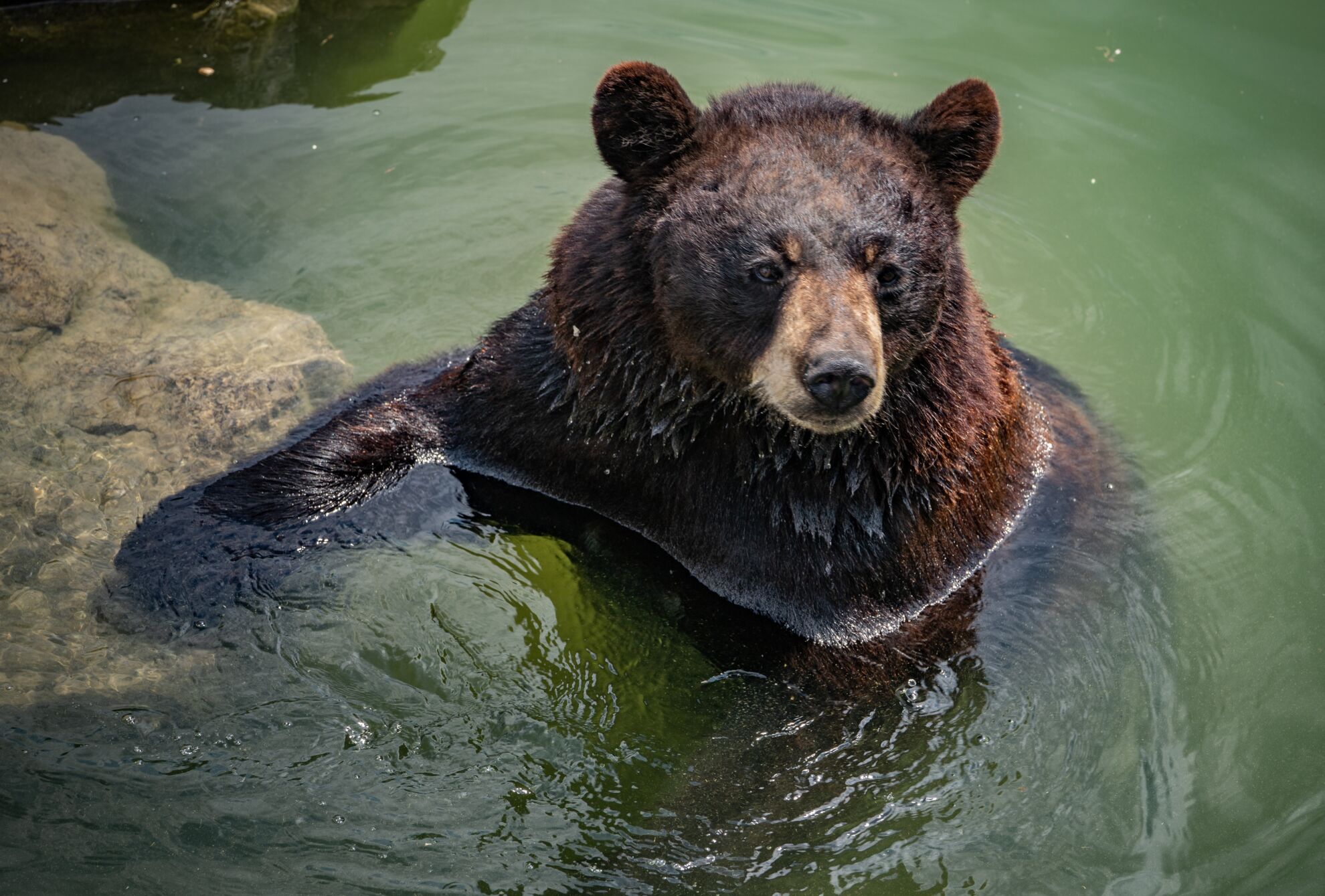
Insects, Amphibians & Reptiles
Often overlooked, their mountain diversity is impressive! Though quieter than large mammals and birds, they’re just as fascinating to those who take the time to look.
Alpine Longhorn Beetle
Among the most identifiable mountain insects is the alpine longhorn beetle, a beautiful blue-black speckled insect easy to spot in summer woodlands.
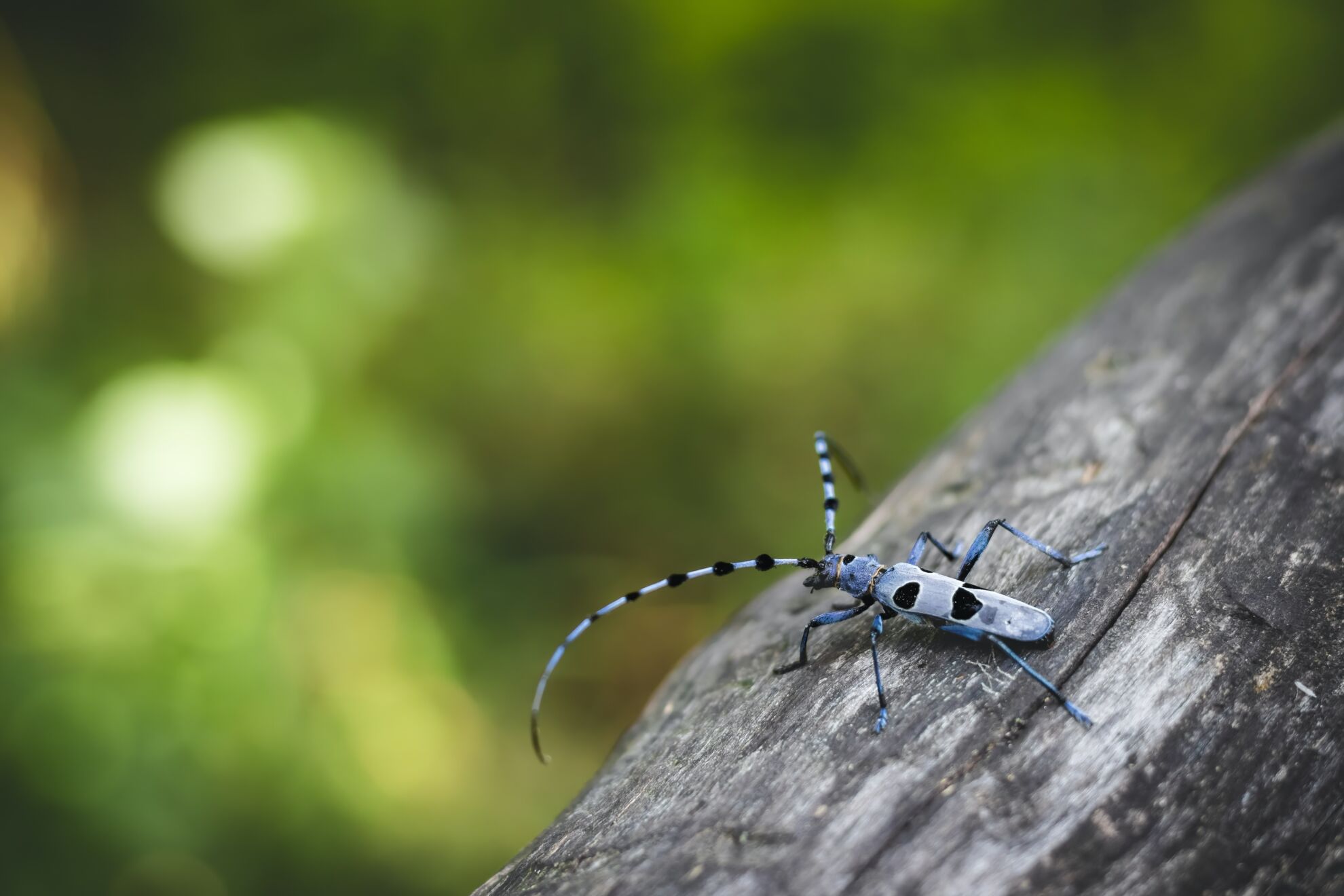
Another alpine jewel is the Apollo butterfly, sporting green, brown, black, and yellow hues, found from 1,000 to 1,600 m.
Alpine Newt
Among amphibians is the alpine newt, named for its vivid red underside. Measuring 7–12 cm, its flattened tail and small limbs let it move equally well in water and on land. Look for it in small pools near mountain lakes.
Salamander
At lower altitudes, the salamander favors damp spots near streams, hidden under stones or logs. Its striking yellow-and-black pattern makes it stand out. It moves slowly, so once you find it, you can observe it easily.
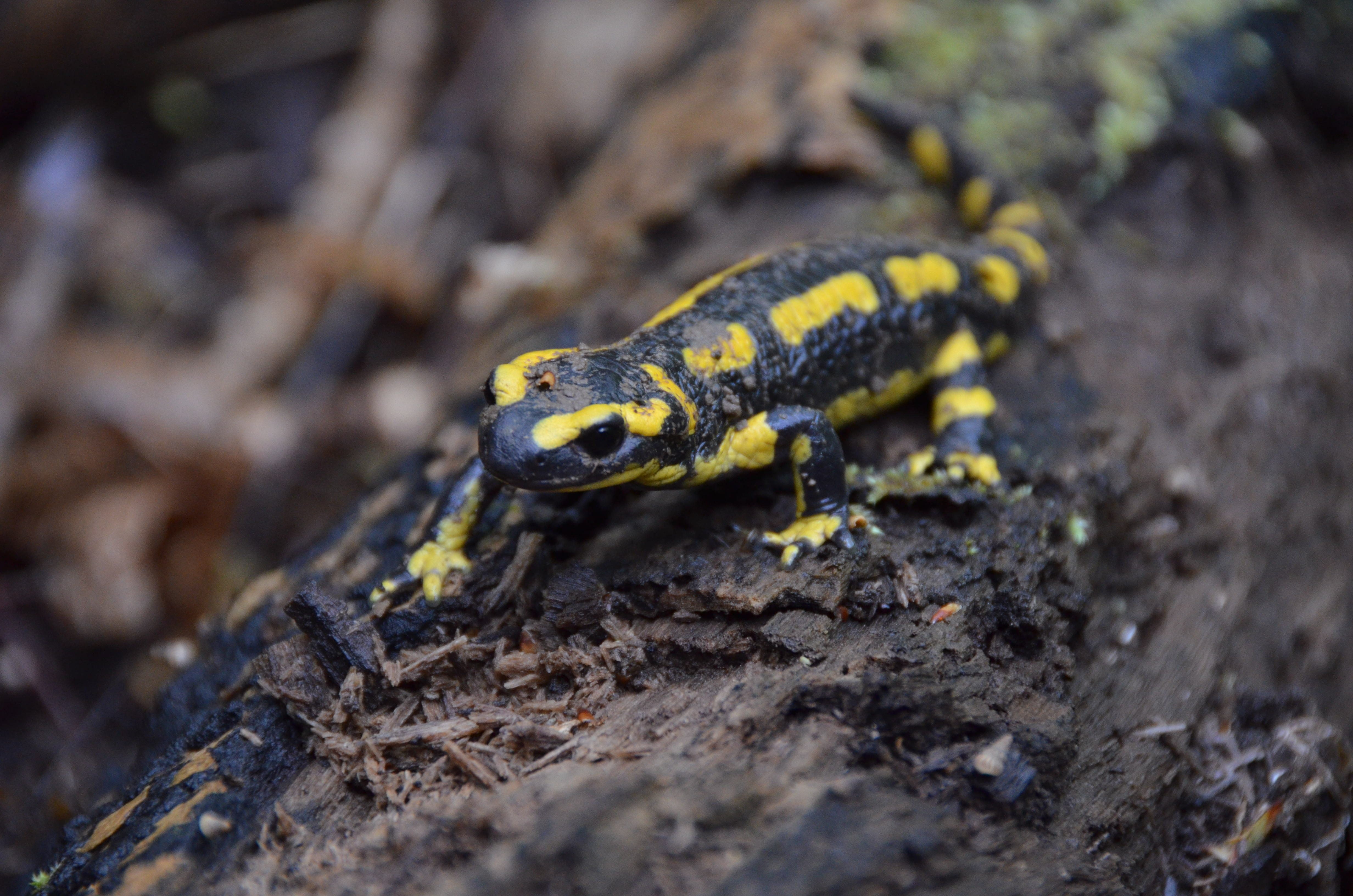
Dahu!
Do you know a mountaineer who hasn’t yet seen a dahu? Whether at dusk, during the night, in the snow, or at a summit.
The dahu is a unique mythical creature—those who claim to have seen it describe it differently.
Some accounts say it has one shorter leg, forcing it to descend on one side of the mountain and ascend on the opposite side!
Others give it horns, sharp teeth, a marmot’s head with a chamois’s body, or the reverse… Ask locals about your area’s dahu—you might be in for surprises!
Best times to observe wildlife
Two parameters optimize your chances:
- Time of day
- Season
Optimal times of day
Animals tend to hide and rest during the warmest parts of the day—both because they tire easily and because that’s when hikers are out!
To spot more wildlife, focus on early morning (5:30 am–9:30 am) and evening after 5:30 pm–6 pm, when the sun sets.
Seasons
We know there are four seasons, but at altitude they’re very distinct, offering varied observation opportunities.
Winter is the most limited for wildlife sightings, though you can still glimpse rare surprises like ptarmigans.
By contrast, spring and summer are prime seasons when animals are more active, searching for food or mating.

Spring (April to June)
Spring is an excellent time to observe many mountain animals as they become active and visible after winter.
Snowmelt makes food more accessible, breeding season begins for some species, migratory birds return, and with fewer tourists, animals spend more time in the open.
Summer (July to September)
Summer also offers great wildlife viewing. Longer sunny days make hiking and observation easier.
In high heat, animals seek shade under trees or rocks, waiting for cooler parts of the day.
Marmots and ibex are especially active. Many mountain birds breed in summer, making them easier to spot.
Getting up very early often yields the best sightings at forest edges and animal pathways.
Autumn (October to November)
Autumn, like winter, is less ideal, but you can still see species like deer during rutting season.
Shorter days and unpredictable weather make wildlife harder to find, and some species begin preparations for winter, reducing activity (e.g., marmots).
Winter (December to March)
Winter is not the best time for mountain wildlife viewing. Many animals hibernate or migrate to warmer areas.
However, chamois, ibex, ptarmigans, and snowshoe hares can still be seen. Tracks in the snow also aid detection.
Snowshoe hares and ptarmigans reveal their stunning white coats in winter—magical, though still very elusive!
Best places to observe wildlife
You don’t have to get very close to witness mountain wildlife.
Certain areas are especially conducive to observation because they are quieter and more respectful of flora and fauna.
French National Parks
There are over a dozen National Parks in France, all dedicated to protecting and showcasing unique wildlife and plant life.
Many are in mountainous regions due to the richness and fragility of these environments. With increasing human activity at high altitudes, animals need protected zones where hunting is forbidden and visitors stay on trails. Some parks even have entirely closed « integral reserves. »
These areas allow nature to develop without human impact—more and more rare in France and worldwide.
National Parks are unique places to observe iconic mountain wildlife.
Be sure to visit the nearest park information center for advice, follow park rules, and help preserve wildlife for everyone to enjoy.
Remote areas away from ski resorts and human activities
The mountains as a whole offer vast wildlife observation grounds. You don’t need a National Park to see animals.
Many trail networks take you through forests or high-altitude terrain where you can spot wild animals, including protected species.
Try to stay away from urban centers, villages, and ski stations to experience less disturbed nature.
You’ll have better chances where animals feel undisturbed.
It’s possible to spot wildlife even in populated areas, but high human pressure often forces animals to reveal themselves only during migrations or when seeking cover.
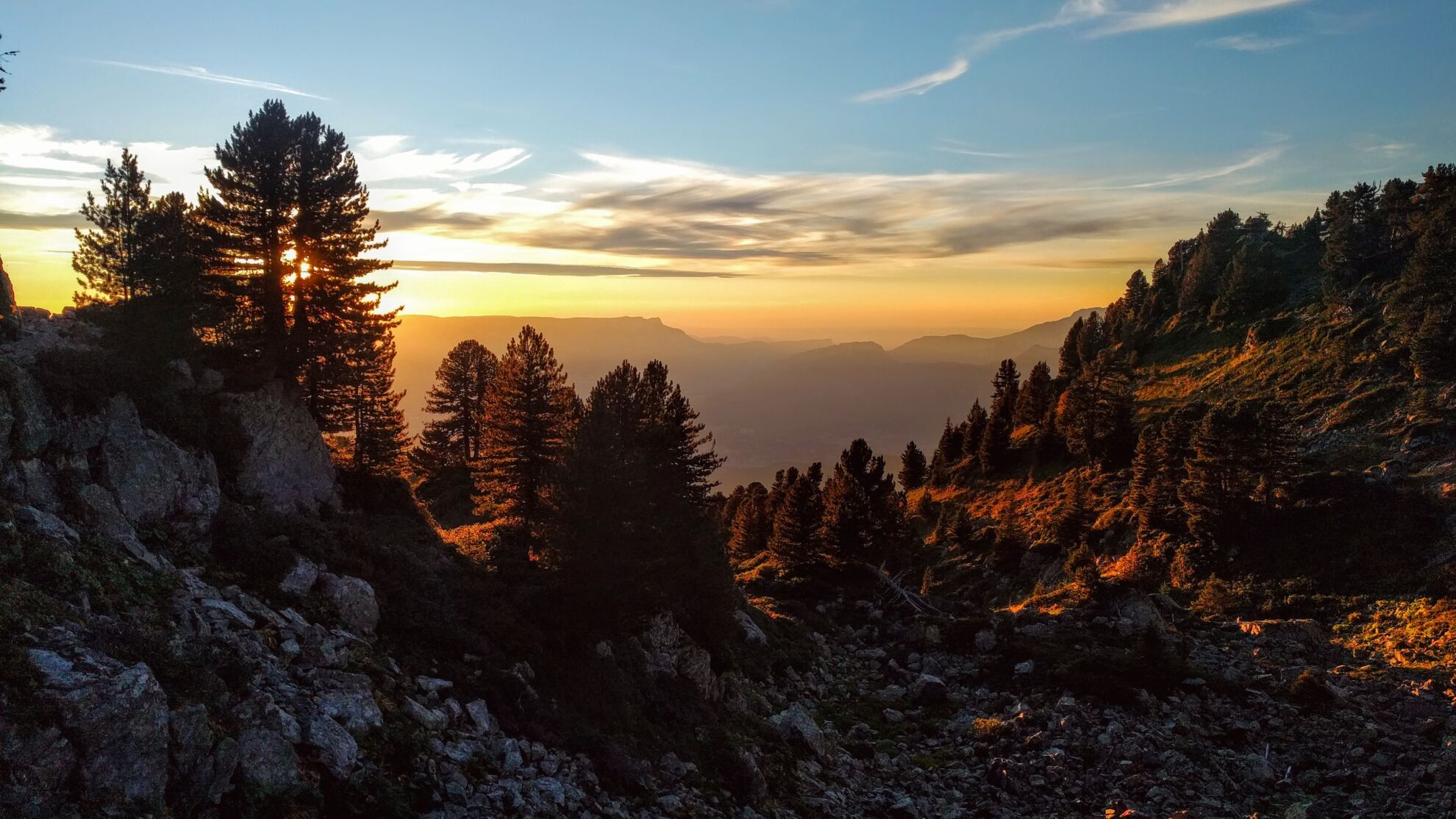
Tips for observing mountain wildlife without disturbing them
If you want a chance to observe wildlife, first respect them: their space, environment, and be discreet. All of this goes hand in hand for the best possible experience!
Be silent
Mountain animals, like all wildlife, have keen hearing. Strange or loud noises cause them to hide. Speak softly, walk quietly, and watch your step to avoid startling birds, chamois, or hares.
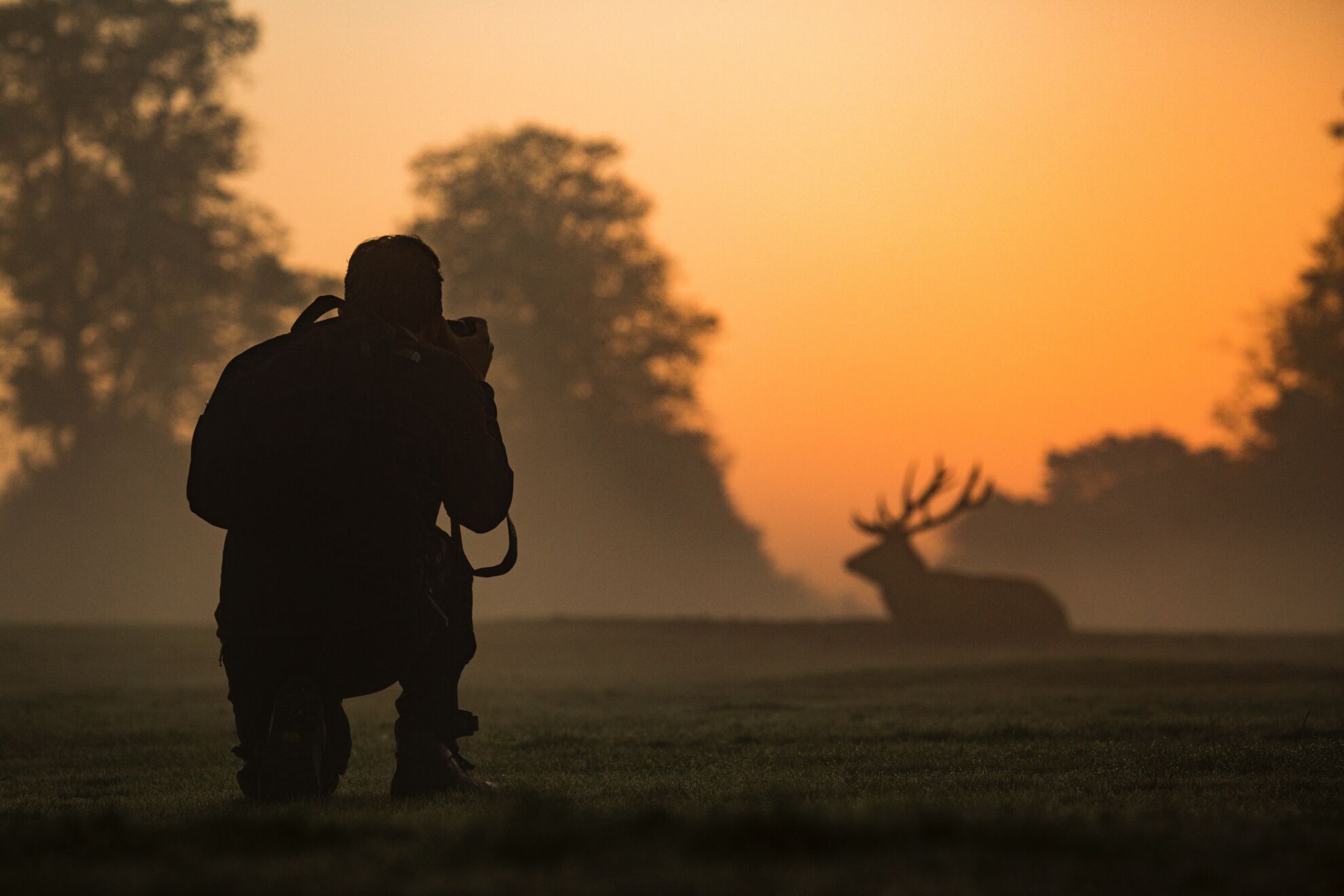
Blend in
Wear neutral colors that merge with the landscape—greens, browns, blacks, and grays. Avoid reflective objects like shiny sunglasses or metal gear.
Avoid using a headlamp unless necessary, especially at dawn, and refrain from sudden movements.
Walk against the wind
Walking into the wind prevents animals from catching your scent before they spot you. While not always practical in mountains, it’s a helpful tactic when conditions allow.
Keep a safe distance
If you’re lucky enough to be close, maintain a reasonable distance. Trying to get closer often adds little to the experience and may frighten animals, causing them to avoid the area permanently.
Use binoculars or a spotting scope
Your best ally for observing wildlife at a distance. Modern binoculars like Silva Epic 10 are light, precise, and perfect for handheld use in a hiking backpack.
A spotting scope offers even more power and stability with a tripod, letting you share detailed views with your hiking partners.
Don’t feed the animals
Never set out to feed wild animals. True wildlife won’t be interested. However, some marmots near refuges have learned to take food from hikers—an unhealthy habit.
Feeding wildlife disrupts their instincts and may lead to dangerous behaviors or nutritional issues.
Ask for local guidance
When in unfamiliar territory, seek advice from mountain guides or park rangers. They know animal habits and can point you to the best observation spots for chamois, bearded vultures, or foxes.
Park offices and information centers are invaluable resources for rules and tips to make your wildlife watching trip unforgettable.
References
- ↑Photo P. Mauerhofer
- ↑Photo F. Martin
- ↑Photo B. Buisson
- ↑Photo B. Buisson
- ↑Photo S. Kranen
- ↑Photo M. Pagano
- ↑Photo Y. Allegre
- ↑Photo Hubi’s Tavern
- ↑Photo F. Tommasini
- ↑Photo H. Veth
- ↑Photo S. Bois
- ↑Photo J. McKenna
- ↑Photo M. Noyelle
- ↑Photo G. Leighton
- ↑Photo P. Audet
- ↑Photo D. Mačura
- ↑Photo D. Parkhouse



Your comments and questions